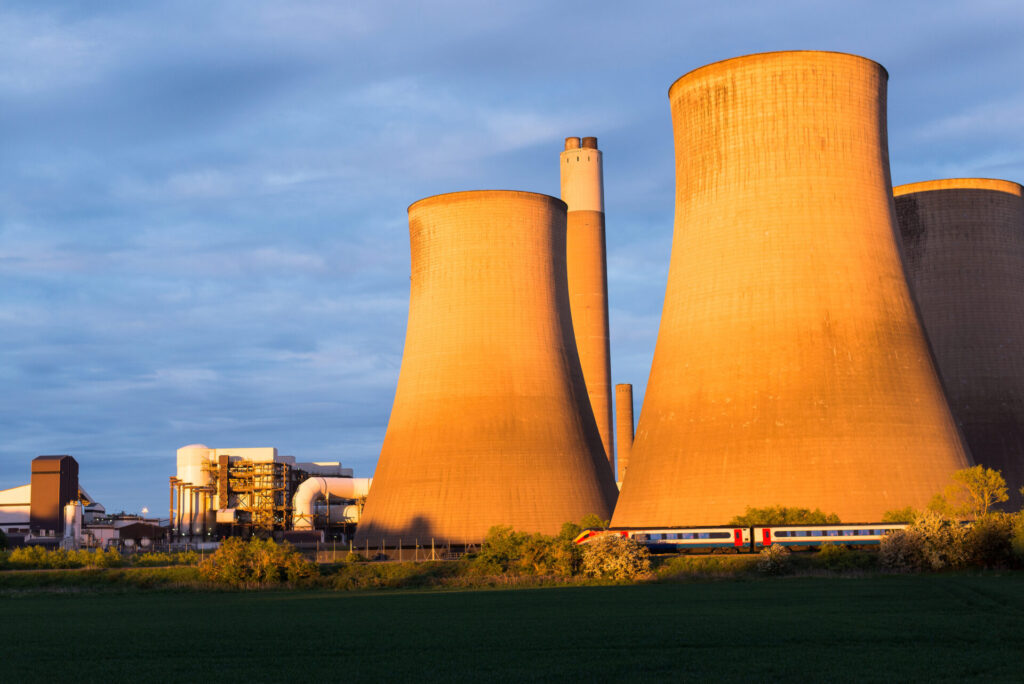On 30 September 2024, the UK’s final coal-fired power unit at Ratcliffe-on-Soar was de-synchronised from the grid. That moment symbolised the formal end of an era: no more coal-fired baseload generation in Britain. Over the following months, the plant entered a phased decommissioning process, preparing the way for its eventual demolition and site transformation.
From Coal Powerhouse to Clean Energy Opportunity
Ratcliffe-on-Soar first came online in the late 1960s and became one of the UK’s most recognisable landmarks, its towering cooling stacks symbolising the country’s reliance on coal. For decades, the plant generated power for millions of homes, contributing significantly to national grid stability.
Its closure in September 2024 brought the curtain down on more than 140 years of coal-fired electricity in Britain. Now, plans have been approved to demolish the site’s remaining structures — including its eight cooling towers, turbine hall, boiler house, and chimneys — to prepare the land for redevelopment.
According to Rushcliffe Borough Council, the demolition will be carried out in carefully phased stages under strict environmental, safety, and ecological conditions. The process will include extensive decontamination and the removal of hazardous materials to ensure the site’s future use aligns with the UK’s net zero ambitions.

Managing the Complex Demolition Process
Demolishing a power station of Ratcliffe’s scale is a major engineering and environmental challenge. The site sits close to major infrastructure — including the A453 and Midland Main Line — meaning controlled implosions must be planned with precision to minimise vibration and disruption.
Before any structural work can begin, a significant decommissioning phase is required. This involves dismantling internal systems, removing equipment, and safely disposing of materials like asbestos and chemical residues. Only once this process is complete can large structures such as the cooling towers be taken down.
The demolition work will take place over several years, with certain stages potentially extending into the early 2030s. The controlled removal of the plant’s vast structures will mark one of the most significant industrial deconstruction projects in the UK’s modern history.
Environmental and Community Considerations
Protecting the environment and local community is a central focus of the approved demolition plan. Environmental impact assessments have guided the approach to air quality, noise, and dust management, while ecological surveys ensure wildlife habitats are preserved or restored.
The project team will work closely with local authorities, transport agencies, and environmental regulators to coordinate the safe handling of materials and minimise disruption to nearby residents. Public safety measures, including exclusion zones during controlled demolitions, will be rigorously enforced.
A Vision for the Future: From Coal to Clean Industry
Once cleared, the 305-hectare site will be redeveloped into a zero-carbon technology and manufacturing hub as part of the Ratcliffe-on-Soar Local Development Order. The vision is to transform the area into a centre for innovation in clean energy, sustainable manufacturing, and advanced industrial technology — creating new employment opportunities and supporting the UK’s net zero strategy.
By repurposing existing grid connections and transport links, the redevelopment will harness the site’s strategic location to drive investment in renewable energy and green infrastructure. It represents not just a physical transformation, but a symbolic one — turning the legacy of coal into a foundation for a cleaner, more resilient energy system.
The Broader Energy Transition
The demolition of Ratcliffe-on-Soar is more than the dismantling of a power station; it’s the visible expression of a nationwide energy transition. The UK has moved from a coal-dominated grid to one powered primarily by renewables, with wind, solar, and nuclear now forming the backbone of electricity generation.
As coal exits completely from the energy mix, the focus shifts to ensuring reliable, affordable, and low-carbon energy supply. The redevelopment of legacy sites like Ratcliffe will play a key role — providing space for innovation and reinforcing the infrastructure needed to meet the country’s 2050 net zero target.
The demolition of Ratcliffe-on-Soar marks the end of an era, but it also highlights the UK’s determination to lead the global shift toward sustainable energy. By transforming this historic site into a hub for clean technology, Britain is not just closing the door on coal — it’s opening a new one to a more sustainable, forward-thinking energy future.





